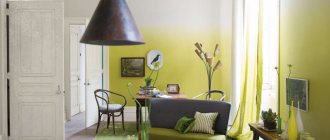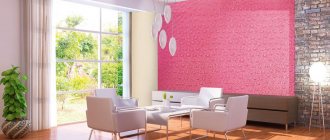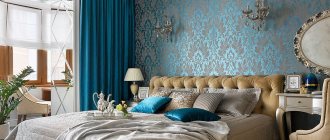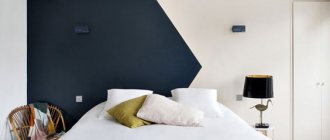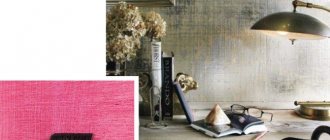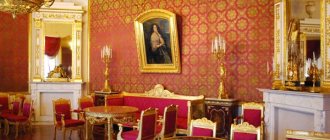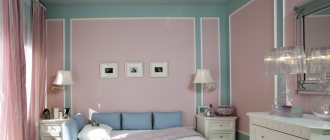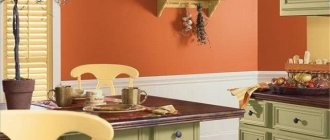When choosing a method of finishing walls, preference is increasingly given to painting. We wrote about the pros and cons of this method in the article “Guide to choosing wall coverings: wallpaper or painting?” Walls painted in the traditional way will be a suitable backdrop for both modern minimalism and vintage decor. However, when working with paint, you can get really creative by combining colors and shades. Some ways of combining paint will bring crazy pop art energy into the interior, while others will help create a harmonious background for a luxurious classic interior.
It is generally accepted that painted walls, unlike those covered with wallpaper, look dull and uninteresting. It's a delusion! Firstly, the paint can be tinted in absolutely any color. There is no such freedom with wallpaper: what the designers created is what you have to use. Secondly, the paint can be combined to achieve amazing effects. With wallpaper it is not always possible to achieve such interesting results.
Combining paint colors is not so easy. You will have to work very carefully. It is necessary to purchase a good masking tape that will not only protect the surface from paint, but will also be easily removed from it without pulling the finish layer with it. In addition, painting in two colors will require precision calculations, measurements and markings. You will also need patience, because some dyeing methods may take several days (step-by-step dyeing).
How to paint walls in two, three or four colors? There are several popular combination paint designs. When choosing, you need to take into account the style of the future interior, the features of the room layout, and, of course, personal preferences. So, let's look at the basic techniques for painting walls in several colors. But first, about some important nuances.
Combined wall painting: useful tips
A color scheme
There are three possible combinations:
- close or related colors: for example, two neutrals (black and white, gray and beige) or two cool pastels (blue and mint)
- “gradient”: tones of the same color of different saturation
- different colors: for example blue and red, green and orange
Having chosen the last color plan, try to choose shades that are similar in saturation, temperature and “sound”. If, for example, you take not orange, but peach, then instead of grass green it is better to use olive.
Designing a border between different colors
The border between two colors is not always perfectly neat and even. But this is not a problem: the joint can be decorated with polyurethane molding, paper border, wooden slats, plastic strips or, for example, borders made of stone, mosaic and pebbles - they just need to be glued to the joint line using liquid nails or other reliable glue.
Tinting with reserve
If you select shades not from a catalog, but guided by your own imagination, order paint tinting with a large margin. If the paint runs out and you have to tint a new portion, a complete match may not be achieved. It is especially important to create a reserve of paint if you are tinting it yourself.
Features of painting walls of different materials
Wooden walls
Painted wooden walls not only look aesthetically attractive, but also extend the life of the wood. Before painting, the old coating must be removed from interior doors or walls made of wood and treated with stain. After drying, apply 1-2 layers of alkyd or acrylic paint.
The photo shows a wooden panel painted pale yellow in a classic bedroom interior with a gray baseboard and light floor.
Brick walls
Before painting, they clean and wash with water; after a week, all the moisture will be released and it will be possible to prime the surface and paint the brick with interior acrylic or alkyd paint. You can age the brick or create smudges. You can use a contrasting color for the seam.
Concrete walls
Before painting, you need to clean it, make the surface smooth and free of cracks, prime it, let it dry and apply epoxy or latex. A repeat layer must be applied to the entire surface of the wall at once to avoid changes in shade.
Wallpaper
Paintable wallpaper is convenient in that it can be repainted without driving pigment into the walls. Such wallpaper can also be removed without sanding or cleaning the surface. Wallpaper paint is water-based without solvents. Textured wallpaper makes work easier and hides uneven walls.
Drywall
Drywall on a wall or ceiling is painted after filling the joints and all the drywall, as well as sanding and priming. They use acrylic or silicone paint, which are plastic and create a protective film.
Plaster
Painting on plaster takes place on a clean, dry surface. If chips are noticed during the preparation of the wall, they need to be cleaned and sealed. Painted with a roller in 2 layers with maximum filling of pores.
Dividing walls horizontally
The part of the wall from the floor is painted with paint of one color, and above - with another. The boundary is usually drawn at about a third of the height from the floor. However, division can be done in another way. For example, exactly in half or with a predominance of the lower part. Sometimes the border runs almost under the ceiling.
Painting walls in two colors: traditional design
Dividing the wall below the midline is the traditional approach. This painting of walls in two colors is suitable for interiors in a variety of styles: classic, art deco, art nouveau, retro, country. When creating elegant modern interiors, this wall design is also justified. Painting with horizontal division creates an imitation of panels - the same ones that are mounted along the bottom of the wall. The border between two colors should be decorated with molding or decorative border.
Other options for dividing walls horizontally with offset color boundaries are usually used in children's rooms and in creative modern interiors.
How to paint? Here's one way. First you need to paint the entire wall a lighter shade. After the paint has dried, measure and draw a border line. Above or below the border, stick masking tape exactly along the drawn line. The tape is glued to the part that will no longer be painted. Next, paint the wall below or above the tape in a second color. In the first hour after painting, carefully remove the tape.
How to paint the walls in an apartment yourself
It is necessary not only to choose the right type of paint, but also to figure out how to work with it. Let's look at the main stages of applying paint:
- removal of old coating. If the old layer is compatible with the new one, then only poorly adhering parts can be removed. If the coatings are incompatible, you will have to remove everything completely;
- The putty is applied with a spatula. At the same time, irregularities and cracks are covered;
- then grinding is carried out. For this, a special mesh or sandpaper is used. Using circular movements, everything unnecessary is removed and the walls are leveled;
- use a vacuum cleaner to remove dust from the surface;
- primer. A specific primer is selected for each paint option. It is better to buy it together with paint;
- painting is done in several layers. In this case, the layers are distributed in different directions. Each layer is applied after the previous one has dried.
Painting with decorative paint
You can watch the video to see how to paint a wall correctly:
If you decide to leave the repairs to professional hands, then you should know that the standard price for painting walls per square meter varies between 100-150 rubles.
Color inserts
This is another method of painting with imitation panels. First, the wall is painted with paint of one color. After drying, future “panels” are marked. Masking tape is glued along these lines. The inside of the resulting squares or rectangles is painted over with a second color - usually darker, but a variety of solutions are possible. The tape is removed before the paint dries. Painted “panels”, as a rule, are framed with moldings, strips, and borders.
This wall decoration is ideal for classic, baroque and glamorous interiors. Wall decor is usually placed inside the “panels”: for example, clocks and sconces.
Accent wall
This is a fashionable solution that allows you to make a bold statement in the interior without the risk of oversaturating it. Three walls in the room are painted in one color, usually neutral or quite light. The fourth is painted with a different color - it can be very discreet or very bright, depending on the desired effect.
Only part of the wall can be painted - for example, in the form of a wide vertical stripe. Read more about creating an accent wall in our article.
"Gradient"
This is a method of combined painting similar to the previous one, in which the entire surface of the wall has one color, different from the color of the other walls. But in this case, paint is used not of different colors, but of tones of the same color of different saturation. A sort of gradient is created. You can use 4 tones - a separate shade for each of the walls of the room.
Where to begin?
Everyone knows how to paint a ceiling - what could be simpler? It’s more difficult with walls, especially if we are talking about painting the walls in several colors. The mechanism for painting with different colors is the same for both walls and wallpaper for painting.
1. Choose a color combination. You already have a rough idea of what combinations are close to you: calm or rich, smoothly flowing into each other or contrasting. You can select colors based on four types of combinations:
- Tones of the same color, different in saturation and intensity.
- Coordinating color palette (neutrals, pastels).
- Different colors that set off each other in contrast. In the diagram they are opposite each other.
- Using white color, which is 100% compatible with any color.
2. Choose a color scheme.
- Colors that will be repeated in the interior or furniture elements will add special coziness and comfort to the room.
- Cool colors will visually expand the room and add severity and sedateness.
- Pastel colors that play with natural shades will make the room more tangible and warm.
Carefully consider the combination of colors and the future color scheme of your walls. You will be staying within these very walls for more than one year!
3. Make sure you have a sufficient amount of tinted paint. If you suddenly run out of material for work, it will be difficult to achieve accurate tinting. It is necessary to prepare masking tape for work, which allows you to carry out the work cleanly when painting and delimit the space of the walls.
4. It is not always possible to follow a strict line when painting walls in two colors, so you need to think about finishing at the joints: borders, decorative stones, frames, mosaics - all this is suitable for effectively decorating walls of different colors.
In the video: a painting method that does not require masking tape.
Continuous horizontal stripe
This is a simple but very effective way to add variety to your wall design. First you need to paint them in one of the colors. After drying, mark two lines - the upper and lower boundaries of the future wide strip. Apply masking tape along these lines (outside the future strip). Now you need to apply the second color of paint inside the markings. Without waiting for it to dry, remove the tape.
This combination of painting walls in two colors is good for a corridor - a horizontal stripe visually reduces its height, making the room seem a little wider and more spacious. Wall decor is placed inside the strip - for example, small paintings or photo frames. In a children's room, the stripe can be decorated with stenciled designs.
Combined coloring options
Here we will not talk about painting technologies, but about how in the design the walls are divided into zones of two different colors. There are 10 original and winning approaches.
Dividing the wall horizontally
One part of the wall area from the floor is painted with one color, the part that is higher will be painted with a different shade. The border is most often set at about a third of the height of the wall from the floor. But you can show your imagination and draw the line somewhere else. For example, you can divide the wall in half or make the lower part larger. Sometimes designers create a border even under the ceiling.
The traditional way of painting is to divide the wall into two parts below the midline. Painting wallpaper or a wall in this way is ideal for various interior solutions - this is true for both classic and modern style trends. The process of painting walls in two colors in apartments with walls divided horizontally allows you to get the effect of panels that are usually installed at the bottom of the walls.
In this case, the border between two colors is formed using moldings or decorative elements.
How to paint? First, the wall is painted in light colors. After the paint has dried, mark and draw a line - this is the future border. Painting tape is placed below or above this border. It should be applied where it has already been painted. Then the area above or below the border is painted in the 2nd color. The tape is carefully removed.
Related article: Pink color in different rooms: several rules of use
Colored inserts
This technology also imitates panels. First, the wall is painted in one of the selected colors. When the paint is completely dry, mark the work surface. Adhesive tape is applied along the drawn lines. The result will be square or rectangular areas - they are painted over with a darker color on the inside. Then the tape must be removed before the paint dries. By showing imagination and creative abilities, you can apply other original solutions.
It should be remembered that this method of finishing is ideal for a classic - an entrance hall in the Baroque style or another glamorous style.
Accent walls
This approach makes a bold statement without the risk of oversaturation. Most often, neutral or light colors are used to cover three of the four walls in the room, and the last, fourth wall, will have a different shade. The color can be anything - very restrained or rich and bright. It all depends on the desired design effect. Naturally, there is no strictness here. You can paint not the entire wall, but only a part. For example, you can make a wide vertical stripe.
Gradient power
Everything here is similar to accent coloring. The entire surface in the room is covered with one selected color, and one part should be different. But the secret is that they do not use different colors, but tones of the same color differ in saturation. The result is a gradient. Designers often use up to four tones - the hallway is painted in one shade, the bedroom in another, for the walls in the kitchen a third color is used.
Horizontal stripes
This is a very simple, yet effective way to get an original wall. The technology is simple: first, the entire work area is painted with one color. When the paint is completely dry, mark the lines - these are the lower and upper boundaries of the large stripe. Tape is placed along the lines and painted with a different color, but only inside the lines. Experts recommend peeling off the tape while the paint is still wet.
This option is ideal for corridors and hallways. The strip will visually make the ceiling lower, and the entire room will become a little wider and more spacious.
It is enough to use two or three tones and the wall can easily turn into striped. It must be said that this process is quite labor-intensive, but the result is worth the time spent. The easiest way is to make a wide strip - in this case, you will need less work with tape, and the result will look neater. A wide stripe looks softer than a narrow stripe.
Complex shape
Coloring using two or more colors may vary. The most bizarre options will do. For example, the border between two shades can be in the form of an arc, wave or zigzag. The second color can be placed on top of the main color in circles, ovals and various geometric shapes.
Related article: Shades of white in interior design
The interior is a fantasy. To get a truly stylish apartment, you just need to think, and then take the appropriate colors, roller or brush and turn a boring apartment with gray walls into a dream home.
It’s actually easy; with these secrets of painting a wall in two colors, your apartment design will be as original as possible. Painting walls or wallpaper in two colors is an opportunity to get away from imposed standards, so you shouldn’t wait long - your dreams should come true.
Gradient painting of walls (2 videos)
Options for painting walls in two or more colors (42 photos)
Stripes on the walls
Using paint of two or three tones, you can turn a plain wall into a striped one. It is worth saying that this work is very painstaking, but the result is worth it.
Using two methods at once: dividing horizontally and painting with stripes
It’s easier to apply wide stripes: less fuss with tape, and not so many blots. In addition, wide stripes look softer and more unobtrusive.
Read more about the nuances associated with incorporating stripes into room design in our article “Striped walls in the interior: in the rhythm of color and size.” We wrote about how to make a wall striped in our other article: “Painting walls with stripes.”
Combined striped paint can be used not for all walls, but to create accent pieces. The strip can be either vertical or horizontal.
Diamonds on the wall
This is a vintage solution, ideal for decorating a nursery, bedroom or kitchen in a retro style.
No less fuss, and probably even more, than with stripes. But the result is no less interesting, and most importantly, unusual: a wall painted in this way resembles an “old school” knitted vest. Thanks to this, the interior acquires a special warmth and naive charm.
Painting walls with diamonds will force some tinkering. First you need to paint the wall in the lighter of the selected colors. Then, when the paint has dried, mark out future diamonds. Decide what their alternation will be. Note which diamonds will be darker and which will remain light. Apply masking tape along the border of the diamonds that need to be painted a darker color (outside of the marking line). Paint the surfaces inside the markings and remove the tape. After the paint has completely dried, you can draw solid or dotted lines intersecting the sides of the diamonds. This will increase the similarity with the famous knitting pattern.
Pros and cons of painted walls
At first glance, this is the simplest type of wall decoration; the market offers a wide selection of types of interior paints that do not have an unpleasant odor and dry quickly. There are features to consider when painting walls.
Advantages:
- large selection, use of colors;
- no harmful fumes when interior paint dries;
- You can paint the walls yourself;
- simple decoration can be made using a template and a texture roller.
Flaws:
- The preparation of the walls causes great difficulty;
- emphasizes the unevenness of the wall;
- When repainting, the previous layer will need to be removed.
The photo shows a gray bedroom with a brick wall and smooth plastered walls; a bright accent of the interior is the red decor.
Niches, ledges, openings
Combined painting is designed to emphasize the geometry of such structures and place emphasis on them. Any recesses, niches, openings, as well as parts of the walls behind racks and shelves can be painted in a color different from the main color of the walls.
Complex shapes
Combined painting of walls allows you to introduce any, even the most bizarre, shapes into the interior. For example, the border of two colors can be arched, wavy, zigzag, etc. The second color can be superimposed on top of the first in large circles, ovals, triangles, etc.
Color lines can follow the shapes of furniture, decor and other interior details. This is an excellent solution for modern interiors and for rooms in a bright pop art style.
They usually paint without using tape. They simply mark the joint line, paint it a little with a roller, then carefully work with a brush, creating a clear, even border between the two colors.
Fashionable colors in the interior 2021: Bathroom
Are you thinking about how fashionable colors will look in the 2021 bathroom interior? When choosing an option, proceed from the preferred style of the room.
Minimalism and eco-design are trending. The most preferred colors for them are grey, white and various shades of brown.
Designers also suggest actively using blue and turquoise, which go well with white. For those who like unusual solutions, red and black-white-yellow combinations would be a good solution.
Polka dot walls
This idea is usually embodied in children's rooms. Although polka dots are also appropriate in living rooms, bedrooms, and kitchens, if we are talking about styles such as country and retro. Painting walls with polka dots is easy: first you need to paint the walls with a lighter paint, then using a stencil, using a brush or sponge, apply another color or several other colors in the form of randomly or systematically located circles.
